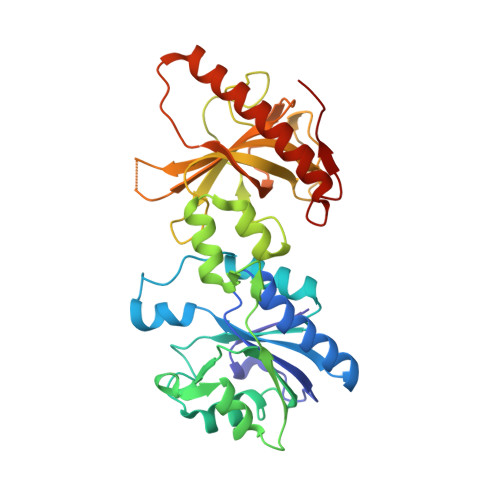Key Residues at the Riboflavin Kinase Catalytic Site of the Bifunctional Riboflavin Kinase/Fmn Adenylyltransferase from Corynebacterium Ammoniagenes.
Serrano, A., Frago, S., Herguedas, B., Martinez-Julvez, M., Velazquez-Campoy, A., Medina, M.(2013) Cell Biochem Biophys 65: 57
- PubMed: 22892871
- DOI: https://doi.org/10.1007/s12013-012-9403-9
- Primary Citation of Related Structures:
3ZUG - PubMed Abstract:
Many known prokaryotic organisms depend on a single bifunctional enzyme, encoded by the RibC of RibF gene and named FAD synthetase (FADS), to convert Riboflavin (RF), first into FMN and then into FAD. The reaction occurs through the sequential action of two activities present on a single polypeptide chain where the N-terminus is responsible for the ATP:FMN adenylyltransferase (FMNAT) activity and the C-terminus for the ATP: riboflavin kinase (RFK) activity. Sequence and structural analysis suggest that T208, N210 and E268 at the C-terminus RFK module of Corynebacterium ammoniagenes FADS (CaFADS) might be key during RF phosphorylation. The effect of site-directed mutagenesis on the RFK activity, as well as on substrates and products binding, indicates that T208 and N210 provide the RFK active-site geometry for binding and catalysis, while E268 might be involved in the catalytic step as catalytic base. These data additionally suggest concerted conformational changes at the RFK module of CaFADS during its activity. Mutations at the RFK site also modulate the binding parameters at the FMNAT active site of CaFADS, altering the catalytic efficiency in the transformation of FMN into FAD. This observation supports the hypothesis that the hexameric assembly previously revealed by the crystal structure of CaFADS might play a functional role during catalysis.
Organizational Affiliation:
Departamento de Bioquímica y Biología Molecular y Celular, Facultad de Ciencias, Universidad de Zaragoza, Pedro Cerbuna, 12, 50009 Saragossa, Spain.















